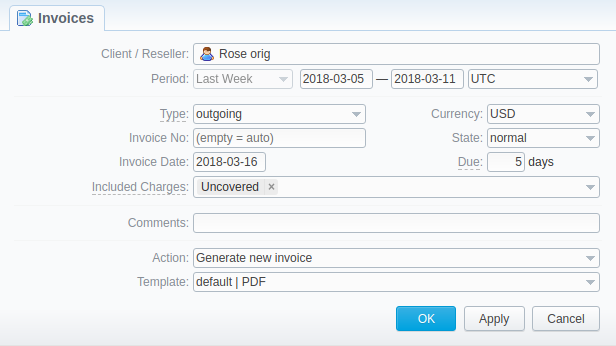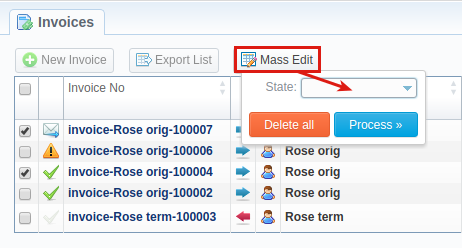Docs for all releases
Page History
...
Functional buttons and icons, presented in the section are as follows:
| Buttons/Icon | Description |
|---|---|
| Allows creating a new incoming invoice in the system | |
| Allows creating a new outgoing invoice in the system | |
Allows exporting a list of invoices in a .csv file | |
| Allows managing the state for the selected invoices in the list | |
| Indicates normal state meaning that a respective invoice was paid in full. If the invoice is not fully paid, the icon will be grey | |
| Defines to verify state meaning that this invoice is waiting to be checked before it is sent to a client | |
| Defines to send state meaning that invoice is in sending queue | |
| Indicates outgoing invoice | |
| Indicates incoming invoice | |
| Allows downloading a respective invoice file in a .csv format | |
| Allows downloading an xDR file, if one is attached to invoice. If there are no attached xDR files, the icon will be grey | |
| Allows deleting a respective invoice from the list |
Advanced Search
To filter data in the section, use the Advanced Search drop-down menu, which can be accessed by clicking a blue downward arrow
Screenshot: Advanced Search drop-down menu
Creating a New Invoice
Invoices are created through the New Invoice button. When you click on it, a pop-up window shows up:
Screenshot: Create Invoice window
| Field | Description | ||||||||||||
|---|---|---|---|---|---|---|---|---|---|---|---|---|---|
| Client/Reseller | Name of the client or reseller | ||||||||||||
| Period | Define a period of statistics that will be included in an invoice | ||||||||||||
| Type | Specify the type of invoice: outgoing or incoming. By default, the Type is set for incoming for your convenience as that's usually the case for manual Invoices creation. Outgoing Invoices are usually automatically generated. | ||||||||||||
| Currency | Select invoice currency from a drop-down menu | ||||||||||||
| Invoice № | A number of an invoice. The number length can't exceed 200 symbols | ||||||||||||
| State | Select the state for a new invoice:
| ||||||||||||
| Invoice Date | Specify the actual invoicing date | ||||||||||||
| Due (days) | Define a number of days when an invoice is expected to be paid | ||||||||||||
| Included Charges | Select the type of charges for invoices:
Please note, these charges don't include calls. Therefore, call charges will be added to any invoice regardless of the Included Charges settings.
| ||||||||||||
| Comments | Specify additional information if necessary | ||||||||||||
| Action | Select one of two available actions: | ||||||||||||
Generate new invoice | A new invoice will be generated, based on predefined templates in the Invoices Templates section. To select a target template, select it from the drop-down menu in the Template field. | ||||||||||||
Attach existing invoice | If this option is selected, the following additional fields are displayed:
| ||||||||||||
| Panel | ||||||||
|---|---|---|---|---|---|---|---|---|
| ||||||||
| Tip All automatically created invoices will have to verify state. To send an invoice to a client, you will need to change the state to to send manually! |
| Panel | ||||||||
|---|---|---|---|---|---|---|---|---|
| ||||||||
Warning When generating invoices under one reseller for different clients, it is recommended to wait till the invoice for one client will be generated and only after that start generating the other one (avoid generating them simultaneously). That is important to avoid the situation of having invoices with an identical number in the system. |
Mass Editing
To change invoices state easily, use the Mass Edit button. First of all, you need to select invoices, for which a state should be changed, then specify it from a drop-down list of all states, and click the Process button for applying the change. Also, using the following window, you may delete all marked invoices by clicking Delete all.
Screenshot: Mass Edit button
| Panel | ||||||
|---|---|---|---|---|---|---|
| ||||||
Please note:
|
You can include specific charges by ID in the invoices (only for API). You can check the ID for extra charges and packages in the Transactions section. Then, you need to add the charges_list variable with respective values in the Parameters field of the API Testbed section:
Screenshot: API Testbed settings
Differences in totals
You may have noticed that while creating different reports, such as a Summary report, xDRs list, etc., and then generating an invoice, you can get different totals. Here is a little background on what makes those differences.
Due to the Included Calls (Attach xDRs list to the invoice settings) option in the Invoice Templates, you can create an invoice based on different types of calls:
- All payable - includes calls with any duration that have non-zero costs and use packages;
- Non-zero payable - includes calls with a non-zero duration that have any cost and use packages.
Therefore, invoice totals depend on the selected parameters and settings. For example, whether to include calls with any cost/duration/package or not. However, when you generate a report, the statistics are usually based on all calls. As a result, a difference between invoice and report totals appears; even though an invoice may have completely another totals vs report data.
| Panel | ||||||
|---|---|---|---|---|---|---|
| ||||||
The invoice and report totals could differ if you made a rerating for a previous invoice period or the statistics were updated. |
You may also need to know how totals are rounded and calculated in invoices. To get more information, follow this link or read about the general principals of rounding in JeraSoft Billing in this article.
Besides, take note ofcurrency settings: there you may specify the number of symbols that will be displayed in all reports with cost and rate values in the statistics. Also, it will be shown in the invoices, except total values (totals always have 2 decimal places in invoices).
- Rates precision - the number of decimal places for rates formatting.
- Details precision - the number of decimal places for detailed monetary values formatting. This precision is used for all reports, except for an xDR report.
- Totals precision - the number of decimal places for total monetary values formatting.
Content by Label showLabels false spaces +KB showSpace false sort modified excerpt true reverse true excerptType simple cql label = "invoices" and space = "KB" labels +invoices













